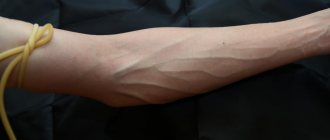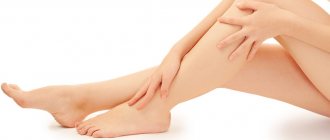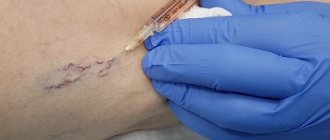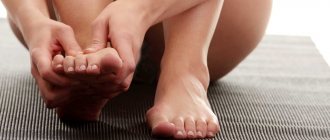The main causes of bruises on the skin
If a woman notices that she has bruises on her legs for no reason, she should identify what is causing them. A bruise in medical language is a hematoma, that is, some accumulation of blood in the damaged area of the skin. In common parlance, such a bruise is called a bruise for its characteristic blue-violet color. This color appears when blood enters the layers of the epidermis from a vessel.
The causes of bruising can be:
- mechanical effects on the skin and blood vessels;
- internal processes within the body.
Internal processes that destroy the walls of blood vessels cause the appearance of bruises. This is a common problem that especially affects women. Doctors name the main reasons for the destruction of the walls of blood vessels:
- Lack of vitamins calcium and potassium in the body.
- Age-related changes leading to weakening of vascular tissue.
- Lack of other microelements leading to thinning of blood vessels. These elements include: selenium, cobalt, zinc, rutin.
- Using special medications to thin the blood.
- Hemophilia, a disease in which blood does not clot well and penetrates the walls of blood vessels and skin.
- Use of special medications that thin the blood.
- Diseases of other organs of the body leading to poor blood clotting.
- The use of medications prescribed for various diseases, one of the dangerous consequences of which may be thinning of the walls of blood vessels.
If bruises appear on the body for no reason, it is important to undergo a timely diagnosis of the causes, as this may be a signal of a serious illness.
Diseases that cause bruising
If bruises appear in women without mechanical causes, this may be a signal from the body about the presence of a serious illness. Such diseases include:
- disturbances in the functioning of the endocrine system;
- problems with the heart and blood vessels;
- varicose veins, which provokes multiple formation of hematomas;
- violation of the level of platelets in the blood;
- kidney and urology problems;
- liver diseases;
- high blood pressure;
- rheumatism.
It often happens that during the treatment of one disease, such potent drugs are prescribed that can negatively affect the functioning of other organs.
Frequent studies have confirmed that when using an anti-inflammatory drug called Ibuprofen, many people experienced bruises on their bodies.
There are many other medications, after the use of which, one of the negative consequences may be the destruction of the walls of blood vessels or blood thinning. If a woman notices bruises on her body after taking certain medications, she should stop using it.
When and which doctor to contact
Usually a doctor is consulted:
- if the rash spreads over a large area;
- when symptoms increase;
- when signs of general intoxication occur;
- if the urticaria does not go away on its own after eliminating the factor that caused it;
- if the disease becomes chronic or often recurs,
It is advisable not to delay your visit to the doctor and come when the first manifestations of the disease occur. Then it will be easier to establish the cause, and treatment will take less time. In addition, the doctor will recommend what to do to prevent hives.
A therapist or pediatrician, a dermatologist can provide assistance with urticaria, and an allergist is involved in targeted diagnosis and treatment.
Diagnosis of diseases that cause bruising
Timely diagnosis of the causes of bruises on the body will lead to treatment being prescribed and eliminating the problem in a short time. To identify the causes, a blood test is performed to:
- platelets;
- avitaminosis;
- foldability;
- leukocytes;
- hormonal composition.
With a comprehensive analysis of blood composition, you can get a clear picture of the disorders within the body.
So an increased level of leukocytes is a sign of inflammatory processes. Accordingly, it is then necessary to identify the place or organ that has undergone inflammation. An abnormal platelet level indicates a disturbance in the composition of the blood and the possible occurrence of thrombosis.
The lack of the required amount of vitamins and blood clotting explains the deterioration of the structure of the walls of blood vessels. If the blood is too thick, then stagnation is possible, leading to damage to the walls.
Hormonal imbalances in women directly affect the appearance of bruises on the body.
Having determined the true cause of this problem, it is important to start treatment on time. By choosing comprehensive measures to combat the disease, you can quickly return your skin to its ideal appearance.
Bruises on different parts of the body
When studying the reasons for the formation of bruises on the body, you will notice that in different people they occur mainly in the same places. Based on their location, we can identify the main reasons for their appearance in a particular place.
Table 1. The main causes of bruising in certain parts of the body:
| Part of the body | The most common causes of bruises | ||||
| Legs | Varicose veins | Avitaminosis | Liver problems | Collapsibility | Hormonal disorders |
| Hands | Hemorrhagic vasculitis | Vitamin C deficiency | |||
| Eyelids | Loss of firmness and elasticity of tissues and vessel walls | Hormonal disorders | Oncology | Taking medications that thin the blood | |
| Stomach | Disorders of the cardiovascular system | ||||
| Knees | Avitaminosis | Taking medications that affect liver function | Kidney dysfunction | Phlebeurysm | |
| Fingers of the limbs | Violation of the walls of blood vessels | Hormonal imbalance | |||
If bruising is specific to one specific area of the body, it is important to look at the possible causes and do an in-depth blood test to identify the specific causes of the bruising.
[media=
https://youtu.be/gVxyaYt0eVU
]
Bruises in women after childbirth
Pregnancy is a wonderful period, but at the same time very difficult for the female body. Many women after childbirth notice the formation of bruises on their body in different places. The main causes of bruises after pregnancy:
- phlebeurysm;
- avitaminosis;
- hormonal imbalance;
- decrease in hemoglobin level in the blood;
- taking medications that have an effect on blood thinning.
During pregnancy, the mother's body accumulates all the beneficial substances and transfers them to the child. As a result, a woman does not receive enough vitamins that her body needs and because of this, serious changes occur. The walls of the blood channels become thinner, the blood itself becomes thicker and more immobile.
During this period, blood circulation changes and to improve it, many are prescribed blood thinners.
The vessels cannot withstand heavy loads, and bruising occurs. Those parts of the body that experience the greatest stress are especially susceptible. For pregnant women, these are the legs and stomach. The skin on the abdomen is greatly stretched, as a result of which the capillaries become more brittle. The walls of blood vessels become thinner.
Varicose veins occur in almost half of pregnant women. This is due to the fact that due to the need to supply the uterus with blood, the flow of blood to the lower extremities is limited. Arterial blood stagnates below, resulting in some stagnation of venous blood. Thin blood vessels burst, forming a thin blue mesh on the skin. When there is stagnation in large veins, the channel swells, and they stand out noticeably in the form of bumps on the skin.
Also, after childbirth, a woman’s hormonal levels change. This is a natural process, but sometimes there are failures when the level of a certain hormone is not normal. As a result, this can cause hematomas.
Bruises under the eyes
On women's faces, the skin is thin and the capillaries are located close. Some people have small blood vessels under their eyes constantly throughout their lives. This is due to the fact that the vessels are fragile. For some, this is a congenital feature. But in most cases, the following reasons lead to the formation of bruises:
- Unhealthy Lifestyle;
- drinking alcohol and smoking;
- working on a computer;
- kidney disease;
- heart and vascular diseases;
- eye diseases.
The formation of bruises under the eyes is greatly influenced by an unhealthy lifestyle, bad habits, stress and lack of sleep. Smoking and drinking alcohol have a particularly negative impact. Smoking cigarettes causes blood vessels to narrow. Small capillaries on the face become clogged and characteristic bruises appear. Alcohol affects capillary fragility. With its excessive use, the blood vessels begin to burst, forming bruises under the eyes.
In cases of a stressful lifestyle, long work at the computer, lack of sleep, blood flow towards the face increases. The vessels cannot withstand the increased load, which causes the formation of blue skin under the eyes.
With age, many women also experience worsening blood circulation and increased fragility of blood vessels.
Also, diseases of various organs are a consequence of age-related changes in the face. When the heart malfunctions, blood stagnation occurs, leading to hematomas. Kidney diseases such as pyelonephritis have a particular impact.
That is why it is important to monitor your health and provide yourself with medical care on time. Treating the disease at an early stage will help the body cope with it faster.
Signs
The disease at the initial stage is latent. You can suspect the reticular form of varicose veins of the lower extremities by the bluish color of the skin. Thin veins appear on the legs in the form of:
- tree-shaped (many vessels branch from one base to the left and right);
- cobwebs or stars (vessels extend from the center in different directions);
- lines (even stripes of blood vessels).
Branched veins are especially noticeable at the end of the day after sports, heavy lifting, prolonged static position, running or walking long distances. In the morning the defect on the legs is invisible.
As blood flow worsens, accompanying symptoms worsen:
- discomfort in the calf muscles. Involuntary spasms occur suddenly and disappear after massage of the limbs;
- heaviness and fatigue in the legs;
- burning and itching in the legs and feet.
The clinic is more pronounced during menstruation due to increased blood flow.
Symptoms subside after resting while lying down with legs elevated. Unlike varicose veins of deep veins, there is no pain, swelling and trophic disturbances.
Treatment of bruises
Treatment of the resulting bruise can be carried out at home and with the participation of doctors. It is important to know under what circumstances it is necessary to see a doctor:
- when the bruise has a large diameter, more than 15 cm;
- if it is formed on the site of an important organ of life;
- if the hematoma is noticeably swollen and it is possible that pus has formed in it.
In other cases, the bruise itself is not dangerous and can be left without treatment. But to quickly restore the skin, it is recommended to use topical products that improve the elasticity of blood vessels and have an anti-inflammatory effect.
But the most important treatment is the very cause of bruises on the body, so after identifying it, it is important to begin treatment.
Treatment of bruises due to vitamin deficiency
Vitamin deficiency can occur in any person. Children and women after childbirth are most often susceptible to it. Adding healthy vegetables, fruits, berries, and meat to your daily diet will help replenish the necessary substances.
The appearance of bruises on the skin is mainly due to a lack of calcium, potassium and rutin. There are certain foods that need to be included in your diet. From these products, the body will receive useful substances in the required volume.
Table 2. Vitamin content in products:
| Microelement | Where is it contained? |
| Calcium | Fish, cheese, dairy products, almonds, beans |
| Potassium | Dried apricots, coffee, raisins, almonds, peanuts, parsley. |
| Rutin | Citrus fruits, grapes, cherries, apples, rose hips, raspberries, currants, beets, cabbage, tomatoes, buckwheat. |
Of course, it is possible to administer an intravenous solution containing the necessary microelements and vitamins. But the best absorption by the body has been proven when a person consumes nutrients naturally.
Treatment for hormonal imbalance
Women are especially susceptible to hormonal imbalances after the birth of a child, during menstrual syndromes. During this period, there may be causeless formation of bruises on the legs, arms, and under the eyes. Dealing with this problem is not difficult.
The main thing is to diagnose high or low levels of certain hormones in the blood in time and bring their levels back to normal.
There are many hormonal medications, but in order to choose the right medication and not cause harm in the future, it is important to conduct an in-depth blood test to determine hormone levels.
Also, when treating other diseases with hormonal drugs, a disruption in the level of hormones in the blood is possible. In this case, it is necessary to stop the started treatment in time and replace the prescribed drugs with others.
Treatment for bleeding disorders
In this case, treatment with fast-acting drugs should be prescribed by a doctor, since improper treatment can lead to dangerous consequences.
To normalize blood clotting, nutritionists recommend including foods containing vitamins B9 and B12 in your diet. You can also use them in tablet form, following the instructions for use and for a period of no more than 1 month.
It is important to pay attention to the use of aspirin. It has a very strong effect on blood thinning. Therefore, if the cause of bruises is its use, it must be abandoned.
Treatment for disorders of the cardiovascular system
When diagnosing serious pathologies of the cardiac or vascular system, treatment is prescribed by a doctor. There are different groups of drugs with different types of effects:
- some directly affect the functioning of the heart;
- others dilate blood vessels;
- thin the blood;
- increase blood clotting;
- affect the walls of blood vessels;
- reduce heart rate and blood pressure.
One of the common diseases of the vascular system that affects many women is varicose veins. It often appears as a fine mesh in the calf and hip area. Small stars may also form there, indicating rupture of the capillaries. In this case, it is important to wear comfortable shoes, special tights and treat areas prone to bruising with agents that restore blood vessels.
If you have problems with the heart or blood vessels, it is important to lead a healthy lifestyle. It is necessary to give up bad habits. Smoking has a strong effect on vasoconstriction and can lead to bruising of the skin.
To restore heart function and normalize blood circulation, it is important to engage in aerobic exercise. While walking or running, the blood is saturated with oxygen, which has a positive effect on its composition and on the activation of processes that help strengthen the walls of blood vessels.
Preventing bruises
To avoid having to deal with the causes of bruising on the body at some point, it is important to follow simple rules:
- walk more in the fresh air;
- regularly stretch your legs with a massage, especially in your calves;
- protect yourself from mechanical damage to the skin;
- control your weight and maintain it at a normal level;
- wear high-quality comfortable shoes;
- organize a proper balanced diet, including vitamins necessary for the body;
- monitor your health and conduct a medical examination.
It is recommended to have your health examined once a year if you are feeling well. It is important to be sensitive to your health and, if the slightest signs of pathology occur, diagnose the causes and undergo timely treatment. Proper nutrition and a healthy lifestyle will help maintain health for many years.
I twisted my leg, my ankle is swollen: what to do?
No matter how significant the injury, first aid may consist of:
- Fixing the foot with a splint - real or homemade
- You should not step on this foot to avoid causing further harm.
- Apply ice for pain relief. It will also reduce swelling. This compress can be kept for up to 20 minutes without harm to health. Reapply - only after an hour
- If possible, apply a tight bandage
- It is better if the leg is raised.
First aid must be followed by a consultation with a doctor and a determination of the condition of the ankle and entire foot.










